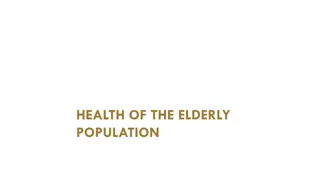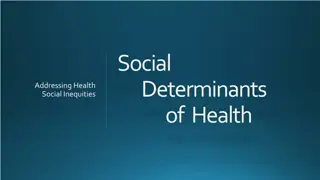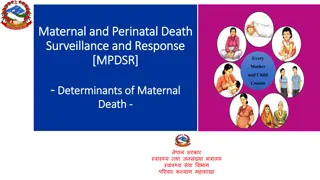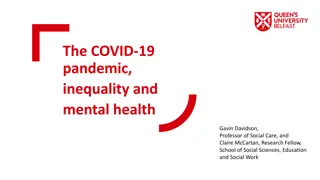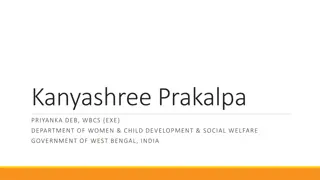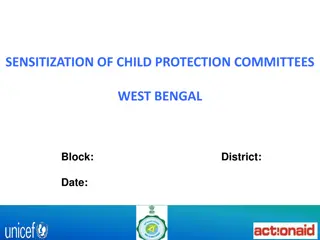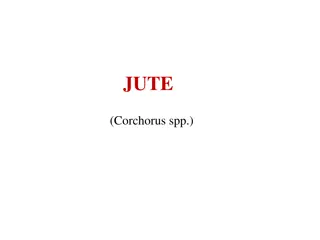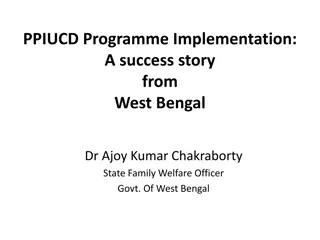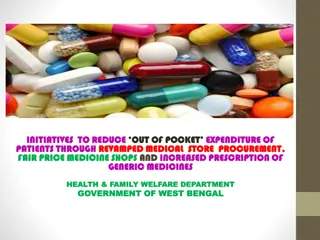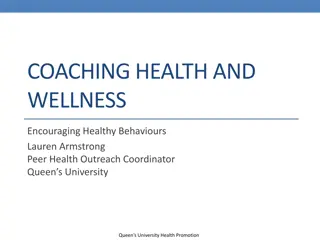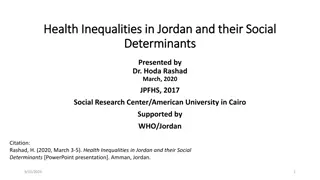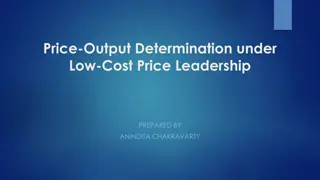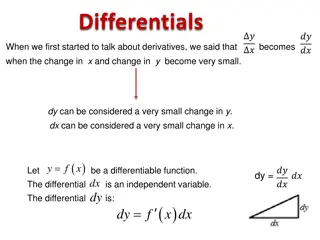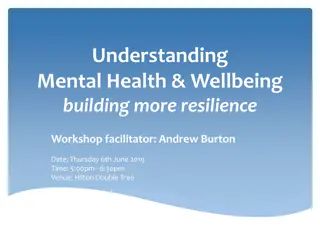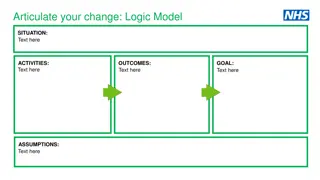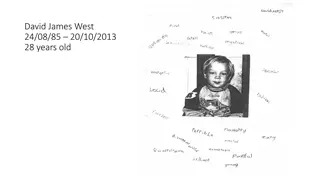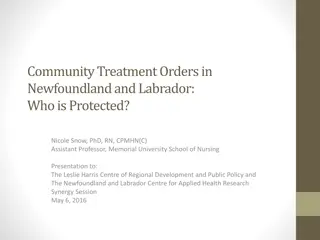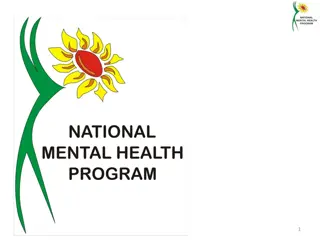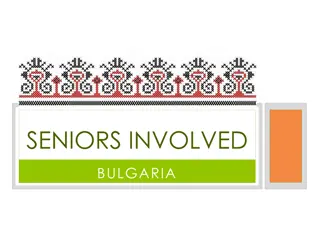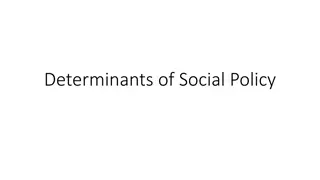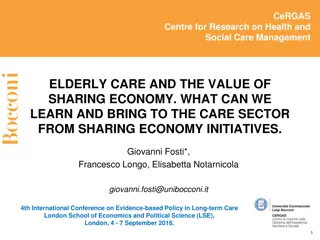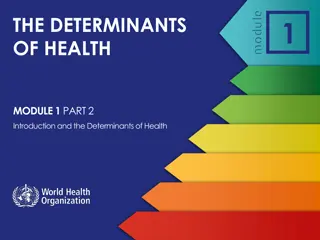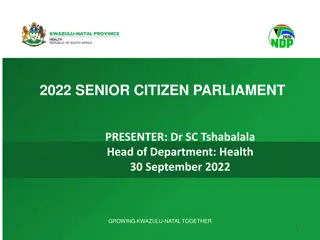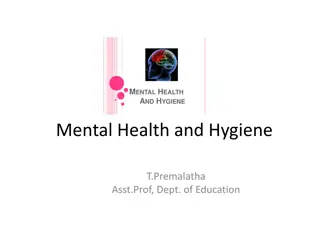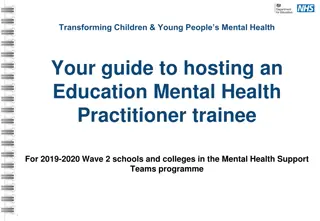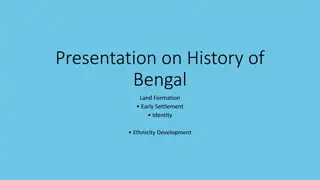Study on Differentials and Determinants of Elderly Mental Health in West Bengal
The study by Pratima Yadav focuses on the mental health of the elderly population in West Bengal, analyzing differentials, socio-economic characteristics, and determinants of mental illness. Findings highlight the growing elderly population, distribution across districts, and prevalence of diseases like chronic morbidities and mental illnesses. The research emphasizes the need for attention to mental health issues among the elderly in the region.
Download Presentation

Please find below an Image/Link to download the presentation.
The content on the website is provided AS IS for your information and personal use only. It may not be sold, licensed, or shared on other websites without obtaining consent from the author. Download presentation by click this link. If you encounter any issues during the download, it is possible that the publisher has removed the file from their server.
E N D
Presentation Transcript
Differentials and Determinants of The Elderly Mental Health: A Study of West Bengal Pratima Yadav, M. Phil Institute of Economic Growth University of Delhi (Delhi) pratimay7@gmail.com 12thGlobal Conference International Federation on Ageing ICC, Hyderabad (India) 12 June, 2014
Organization of the Study Elderly Population in West Bengal: A Few Notable Facts Objective of the Study Sampled Households & Elderly: Basic Characteristics Mental Well Being of the Elderly and Its Differentials Econometric Modeling & Results Conclusion Policy Suggestions 2
Growing Share of 60+ Population: 1961 2026 Source: Decennial Censuses and Expert Group Currently 7.7 million elderly are residing in West Bengal with 37% of them in the urban areas; while 14.2 overall only 32% of the total population resides in urban (Census 2011). About 61% of the elderly 11.9 population are young old (60-69 years) and 27% 10.0 are older old (70-79 years) age bracket. 8.5 7.1 6.0 5.4 5.3 5.0 1961 1971 1981 1991 2001 2011 2016 2021 2026 3
District-wise elderly population in West Bengal (Census 2001) 9.9 5.2 5.3 5.55.76.26.46.6 6.76.9 6.9 7.1 7.2 7.3 7.37.88.28.48.6 While the overall elderly population in West Bengal has risen from 7.2% in 2001 to 8.5% in 2011, districts like Nadia, North 24 Parganas and Kolkata are ageing at a much faster pace. This is particularly true for Nadia that has highest populations of old both in rural (8%) and urban (10%) areas. Urban Kolkata is also greying fast. Local governments may take note of it. 4
Objective of the Study According to Building a Knowledge Base on Population Ageing in India (BKPAI) survey, West Bengal elderly are suffering from various forms of diseases; for example chronic morbidities (at least one 66%), loco-motor disabilities (at least one 88% ) and mental illness (72 % measured by GHQ) etc. However, our main focus is mental health of the elderly in the sate. This study attemt to analyse two issues: 1. Differentials and socio-economic characteristics of those suffering from mental illness. 2. Determinants of the mental illness among elderly in West Bengal. The rest of my presentation evolve around these two issues. 5
Sampled Households and Their Basic Features Household Characteristics Sample elderly households (hhs) are 1157; 51% rural and 49% from urban locales. Mean household size is 4.8. 53% hhs headed by elderly men and 25% by women. Social and Religious Attributes Social group of the hhs are SC (35%), ST (3%), OBC (9%) and Others (53%). Most of the hhs are Hindu (82%) followed by Muslim (18%). Household Structure and Basic Amenities 40% hhs are kuccha (57 % rural and 8% urban) and 38% pucca (22% rural and 67% urban). More than a quarter (38% rural and 6% urban) hhs are without toilet facility. 6
Economic Status of Households Wealth Status: 39% hhs are in lowest wealth quintile, only 10% belonging to the highest wealth quintile. Borrowings: 37% hhs with outstanding loans, one-fifth (19%) to meet medical care of the elderly. APL/BPL card Possession: One-third households possess a BPL card (rural: 40%, urban: 20%). Monthly Per-capita Consumption Expenditure 9.6 % 20.2 % <=1000 13.8 % 1001- 1500 1501- 2000 2501+ 32.3% 47.5 % 29.1 % 26.2 % Urban 21.4% Rural Wide disparity in MPCE across rural and urban elderly households. BPL population in West Bengal , about 82% are elderly widowed women (NSSO 68th Round; 2011-12). 7
Sampled Elderly and Their Basic Characteristics Percentage Distribution of Elderly by Sex & Place of Residence Male Female Total No. of Elderly Rural 46.8 53.2 100.0 643 Urban 46.9 53.1 100.0 632 Total 46.8 53.2 100.0 1275 No. of Elderly 598 677 1275 About 62% of the elderly are young elderly (60-69 years) and 9% fall into 80+ age group. Elderly (60+years) Sex ratio is 1135 and it increase with age (above 80 years is 1376). Nearly 72% of the elderly women are widows as compared to 12% elderly men. However, about 84% of the elderly men are currently married. illiteracy is exceptionally high (62%) and more among rural women (89%). More or less similar result from census 2011 (elderly illiterate 47% & rural women 76%) 8
Components of Elderly Health Objective Health Subjective Health Functionality & Disabilities Cognition Acute/Short- term Morbidity Activities of Daily Living (ADL) Self-rated Health Mental Health Screening (GHQ-12) Chronic Conditions Instrumental ADL (IADL) Life Satisfaction: Subjective Well Being Inventory (SUBI) Locomotor Disabilities Hospitalizations 9
Health of the Elderly: Few Notable Facts Self-Rated Health More than 1/3rd of the elderly in WB perceives their health as poor (rural: 37%, urban: 28%); higher among elderly women (41%) than men (26%). ADL-IADL Functionality Overall 12% elderly requires assistance in performing at least one ADL domain (rural: 13%, urban: 11%). 93% elderly requires assistance in performing at least one IADL activity (rural: 92% urban: 95%). Women reported functional health: 14% requires assistance in at least one ADL and 91% requires assistance in at least one IADL activity. Locomotor Disability Extent of locomotor disability is very high in WB and major disabilities are: Type of Disability Rural Urban Men Women Total Vision 79.4 77.5 78.4 79.2 78.7 Walking 44.4 35.1 39.3 43.2 41.3 Chewing 42.9 31.9 41.6 37.3 39.3 Memory 45.7 23.5 40.6 36.3 38.4 Hearing 34.8 25.6 30.7 32.7 31.8 Speaking 23.9 12.6 20.9 19.4 20.2 10 Full locomotor disability has been reported higher for vision (16%) and others range between 7-10 per cent.
Continued: Mental Health Highest mental illness (measured by GHQ) observed among the elderly in WB (72%) compared to the other states like Punjab (22%) and HP (36%). Overall life satisfaction (measured by SUBI) is lowest for the elderly in WB (mean score 21) as compared to national average (mean score 19). Cognitive Ability Cognitive ability of the elderly is lower (measured by recall of 10 common words). Mean words recalled by the elderly in WB is 3.3 as compared to average 4.1 words recalled across the seven states. 11
Continued: Acute Morbidity Prevalence rate of acute morbidity: 26% (rural: 32% and urban: 14%). Most common acute morbidities: fever (25%), cough & cold (11%) and blood pressure (10%). Chronic Morbidity Two-third of the elderly in West Bengal are suffering from at least one chronic morbidity. Major chronic morbidities: high blood pressure (24%) and arthritis (21%). Hospitalization One out of 10 elderly has been hospitalized in the last one year. Major morbidities responsible for hospitalization were diarrhoea, cataract and accidental injury (12%). 12
Mental Health (GHQ) General Health Questionnaire (GHQ) GHQ is a first screening device to identify psychological distress. The 12 GHQ questionnaire has been used and answerers were rated on a four point Likert scale (0-1-2-3). The score ranges between 0 to 36. A higher score indicates a greater degree of psychological distress. The accepted threshold is 12 or below, reflecting better mental health status. Mean GHQ score for the elderly in WB: 15.90., S.D. : 4.6 We have constructed GHQ response scale w.r.t. below three categories: Category Better Fair Worst Total Construction [Mean 1(S.D.) ) GHQ Score 0-11.26 11.27-20.54 20.55-36 Total 19.06 65.88 15.06 100.00 No. of Elderly 243 840 192 1275 (Mean + 1 (S.D.)] As can be seen from the above table, nearly 80% elderly in WB have rated their mental health as fair or worst. This explains the necessity for a further investigation of determinants for prevalence of such serious mental health condition of the elderly in WB. We will discuss this in the subsequent sections. 13
Differentials of Mental Health Table 1:Percentage distribution of elderly according to their mental health condition by background characteristics Background Characteristic Mental Illness Measured by GHQ No. of Elderly Better Fair Worst Total Sex 19.9 68.2 11.9 100.0 598 Men 18.9 62.3 19.1 100.0 677 Women Place of Residence 16.1 65.8 18.1 100.0 643 Rural 25.4 63.7 10.9 100.0 632 Urban Age 23.6 63.1 13.4 100.0 453 60-64 20.6 64.7 14.6 100.0 341 65-69 16.7 66.8 16.6 100.0 235 70-74 11.6 67.7 20.7 100.0 246 75+ Marital Status 20.6 66.3 13.1 100.0 669 Currently Married 17.6 63.1 19.4 100.0 560 Widowed 14 18.1 72.6 9.3 100.0 46 Others Total 19.2 65.1 15.7 100.0 1275
Table 1 (Continued): Mental Illness Measured by GHQ Background Characteristic No. of Elderly Better Fair Worst Total Work Status 19.0 67.6 13.5 100.0 303 Currently working 19.5 64.9 15.6 100.0 972 Not working Wealth Quintile 13.9 63.4 22.7 100.0 418 Lowest 22.4 66.1 11.5 100.0 857 Others (High) Living Arrangement 16.5 53.2 30.3 100.0 86 Alone 15.2 66.4 18.4 100.0 122 With spouse 19.8 65.9 14.2 100.0 1067 All others Total Worst mental health condition is observed among elderly women, rural elderly, older old (70 years and above), widows, elderly not working currently, those belonging to the lowest wealth quintile and living alone as compared to their counterparts. In contrast, good mental health condition is more pronounced in urban elderly, 19.2 65.1 15.7 100.0 1275 15 young olds (60-69 years), currently married, those belonging to higher wealth quintiles and living with other family members.
Econometric Model Mental Illness of the elderly can be determined on the basis of 7 broader categories of factors: i. Household and Individual Characteristics ii. Economic Factors iii. Social iv. Living Arrangement v. Family and Community Support vi. Health (objective, subjective and disabilities) vii. Spiritual Activities On the basis of it, we have computed a following multinomial logit model. y = + X + i In the above equation y is our dependent variable which represents mental illness of the elderly and it can take 3 values: better, fair and worst based on the GHQ scores. Xi refers to all the independent variables listed in the next slide determining the mental illness of the elderly; improving or worsening the mental health. i refers to the standard error. We have computed a common variable each for sanitation, economic and health measures of the elderly using non-linear Principal Component analysis (PCA) to tackle the high correlation between these variables 16
Determinants of Mental Health There are several factors determining the mental illness in the elderly. We have classified them under 7 broad categories. Type of Factors i. ii. iii. Type of water facility iv. Toilet facility v. Cooking fuel vi. No. of persons in the household vii. Age viii. Illiteracy ix. Marital Status: widowed or not Place of Residence: Rural or Urban Type of hh: kaccha/semi-pucca or pucca 1. Household and Individual Characteristics i. ii. iii. Wealth Quintile: Lowest or higher wealth quintiles iv. APL/BPL card possession v. Outstanding Loan vi. Currently working or not. Monthly Per Capita Consumption Expenditure Personal Income : No income or earns some income 2. Economic i. ii. Caste Religion 3. Social 17 Note: Construction of the variables.
Determinants of Mental Health Type of Factors i. ii. iii. Feels comfortable or uncomfortable with his/her living pattern iv. Faced abuse in last one month living alone/with spouse or with all others. Has a separate room for him/herself in the house 4. Living Arrangement i. ii. Perception of elderly about his importance in the family. Perception of elderly regarding his own worth according to his family. iii. Visits family/friends/relatives iv. Do you have someone you can trust and confide in? v. Chats with neighbours 5. Family and Community Support i. ii. iii. Suffers from at least one locomotor disability iv. Requires assistance in at least one ADL activity v. Requires assistance in at least one IADL activity vi. Suffers from acute morbidity or not. vii. Hospitalized in last one year or not i. Prays Self-rated health: Poor /fair or good/very good/excellent Suffers from at least one chronic morbidity 6. Health 7. Spiritual Activities 18 On the basis of above mentioned determinants we will compute a model to understand their impact on the mental health of the elderly.
Results Table 2: Multinomial Logit Results: Determinants of Mental Health of the Elderly GHQ of the Elderly Independent Variables Better (0<GHQ<11.26) Worst (20.55<GHQ<36) Coefficient Marginal Effects Coefficient Marginal Effects Place of residence: Rural 0.280 (0.205) 0.0337 0.134 (0.231) 0.0072 Sanitation# -0.031 (0.101) -0.0018 -0.157 (0.109) -0.0126 No. of persons in the hh 0.070 (0.033)** 0.0116 -0.196 (0.058)* -0.0170 Age -0.028 (0.014)** -0.0035 -0.001 (0.013) 0.0003 Marital Status: Widowed 0.410 (0.191)** 0.0532 -0.005 (0.214) -0.0061 Illiteracy -0.338 (0.197)*** -0.0503 0.523 (0.230)** 0.0480 Caste 0.406 (0.184)** 0.0573 -0.172 (0.197) -0.0192 Economic Characteristics# -0.328 (0.098)* -0.0456 0.288 (0.103)* 0.0.281 Currently Working 0.037 (0.183) -0.0001 0.337 (0.209) 0.0286 Living alone/with spouse 0.425 (0.266) 0.0634 -0.240 (0.305) -0.0240 No separate room for elderly 0.345 (0.209)*** 0.0468 -0.024 (0.226) -0.0068 Uncomfortable with present living arrangement -0.256 (0.230) -0.03846 0.526 (0.202)* 0.0520 Incidence of abuse in last 30 days 1.060 (0.512) ** 0.1330 1.308 (0.396)* 0.1264 19
Results (Continued) GHQ of the Elderly Better (0<GHQ<11.26) Worst(20.55<GHQ<36) Independent Variables Coefficient Marginal Effects Coefficient Marginal Effects Health# -0.364 (0.066)* -0.0515 0.385 (0.074)* 0.0365 Assistance required in at least 1 IADL activity 0.018 (0.334) -0.0076 1.081 (0.789) 0.0601 Elderly perception about being important for his family 0.081 (0.245) 0.0100 0.012 (0.286) 0.0005 Elderly perception regarding his family realizing his importance 0.689 (0.250)* 0.0975 -0.748 (0.291)** -0.0721 No chatting with neighbours -0.506 (0.169)* -0.0664 0.272 (0.187) 0.0297 No involvement in religious activity: prayer/yoga/bhajan -0.288 (0.164)*** -0.0439 0.532 (0.185)* 0.0483 No confidant/ trustworthy person -0.410 (0.292) -0.0592 0.858 (0.216)* 0.0981 Constant Notes: i. Base category: fair mental health ; Significance levels: * 1% level of significance, **5% level of significance & ***10% level of significance. Pseudo R2 = 0.1734; No. of obs. = 1,272; Log likelihood = -920.91314. Standard errors are given in parentheses. ii. # indicates that the variables have been computed using non-linear PCA technique. Sanitation includes toilet facility, drinking water, kuccha/pucca household and cooking fuel used by the hh. Health includes acute morbidity, at least one locomotor disability, at least one chronic morbidity, assistance in at least one ADL activity and poor self rated health. Economic well-being includes household ownership, MPCE, income of the elderly, wealth quintile, outstanding loans and BPL category of elderly hh. -0.490 (0.979) -2.818 (1.199)** 20
Discussion of Results: Determinants of Better Mental Health Household size is also matter for mental health; an increase household member improves the poor mental health of the elderly (at 1% level of significance). Better health and economic security of the elderly are the two most significant factors (at 99% confidence interval) for mental health of the elderly. Poor health and economic insecurity decreases the likelihood of better mental health condition of the elderly . A person suffering from multiple morbidities is likely to experience mental stress and depression than others. Economic vulnerabilities further deteriorates the mental well being of an elderly. Elderly s perception of his family realizing his/her importance is also a very crucial factor determining their mental health. If the elderly feels that their family also considers them important, then the likelihood of their better mental health will increase, as indicated by the positive sign. Moreover, community support is needed in old age . It has been observed that the elderly persons not able to chat or communicate with their neighbours experience a significant decline in their mental health condition. Better mental health condition decreases as age advances i.e. the coefficient of age has a negative sign with less than 1 per cent impact on better mental health of the elderly. SC/ST elderly are more likely to be in a better mental health as compared to General or OBC category. It might be due to the additional benefits that they receive from the government or due to their happy-go-lucky attitude towards life. 21
Discussion of Results: Determinants of Better Mental Health Nearly 44 per cent of the elderly in West Bengal are widows and it is surprising to note that widowhood have better mental health condition (5% significance level). Our results suggests the importance of spirituality and meditation in improving the mental health condition of the elderly. 22
Discussion---: Determinants of the Worst Mental Health Poor health and economic vulnerabilities highly and very significantly increases the likelihood of worst mental condition of the elderly. Another significant determinant of mental health is elderly perception about his present living arrangement. If he is unsatisfied or feels uncomfortable in his living pattern, his mental health will further worsen leading to serious health complications. Elderly who doesn t pray or meditates is more likely to suffer from worst mental health condition than others. Elderly who have nobody to trust or confide suffers from worst mental health. It is important for the elderly to have a confidant to share their thoughts to sustain their mental peace. Illiteracy slightly (5% significance level) explains the poor mental health condition of the elderly. An illiterate person has a higher likelihood of experiencing poor mental health. This holds true since an educated person has more productive avenues to keep him busy and occupied. Surprisingly place of residence, current work status and poor sanitation facilities have no significant impact on the mental health condition of the elderly. Incidence of abuse in last one month is positively and significantly impacting both better and poor mental health of the elderly. However this results doesn t seem plausible and requires further investigation. 23
Conclusions Major determinants impacting the mental health of the elderly are economic constraints and overall poor health status. Economic constraints are measured by absence of income, low monthly per capita expenditure, belonging to low wealth quintile, having outstanding loans and are BPL households. Elderly possessing these characteristics suffers from worst mental health situation than others. Poor health is measured by self-reported poor health, presence of at least one chronic or acute morbidity, locomotor disabilities, assistance required in ADL activities and hospitalization. Elderly suffering from either of these health complications are reported to experience high mental stress than their counterparts. A closely knit family or friends whom elderly can confide or trust, have children and grand children and lives comfortably serve as ingredients for better mental health of the elderly. It is important for the family to ensure the elderly that they are important members in the house as it strengthens their mental peace. Incidence of abuse significantly worsens the mental health of the elderly. It is essential for the government of West Bengal to spread awareness among the elderly regarding legal provisions made for them to protect them against any kind of abuse. Saanjhbati is an initiative by the state government to provide physical security to the elderly but it does not entail abuse in the form of disrespect and verbal abuse. Elderly having a congenial social environment experience better mental health. 24 Disposition towards spiritual values helps to maintain good mental health.
Policy Suggestions The findings from this study have highlighted the need for elderly- friendly policies and programmes to enhance mental health of the elderly in the West Bengal are: 1. Improvement in Overall Health Condition of the Elderly Psychological health facilities in India are not adequate compare to other types of medical care and services . It is still one of the less important area of research, policy and programme. Therefore, government should set up psychological units in the local government hospitals at the PHC/CHC levels to provide psychological counseling and medication to people suffering from the mental illness. Doctors may visit these hospitals on an alternative day or weekly basis. State government should ensure availability and accessibility to best medical care and health facilities to the elderlyto mitigate the high cost of medical expenditure. Health infrastructure in the state needs to be improved. Geriatric care centers should be expanded and specially trained professionals should be deployed to provide care to the elderly. 2. Insure Economic Security of the Elderly It has been observed about 50 % of the elderly in WB have no income and they experience huge economic vulnerabilities. It is high time for the government to introduce a universal old age pension for the elderly in order to ensure them a decent life. 25
Continued: Familial Support and Intergenerational Bonding Loneliness is bad for mental health and this has turn out to be one of the major fact from our study. Elderly who reside in a household with a higher number of family experiences a better mental health than others. India has largely followed a joint family system in the past which has been replaced by nuclear families in the recent few decades. It is interesting to note that incidence of mental illness among the elderly has increased manifolds in the same time period. It is important to strengthen the intergenerational bonding among the young and the old. It is important to encourage the elderly regarding their contribution in the households because it boosts up their importance in the family and keeps them in good psychological condition. Community Initiatives It is also important to strengthen the role of community to promote healthy ageing. State government should set up Day Care Centers so that elderly can spend their time productively.Local initiatives like Dada-Dadi Park and Laughter Clubs should be encouraged to provide a healthy social space to the elderly to communicate and share with their peers. Private sector can participate in providing funds for the community response initiatives through their Corporate Social Responsibilities (CSR) channel and help in providing an elderly friendly environment to a rapidly growing cohort of the population in the state. 3. 4. 26
Many Thanks for your kind attention 27



